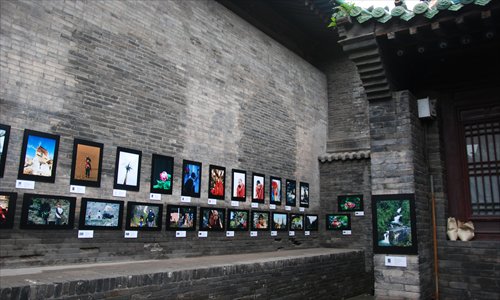Dwelling in the darkroom

Photo: Liao Danlin/GT
The 12th annual China Pingyao International Photography Festival in North China's Shanxi Province this year features almost 13,000 photos taken by over 2,000 domestic and foreign photographers. Exhibition spaces are expanded to eight zones to include two old factories, one warehouse and five tourist attractions in the old town of the city. Running from September 19 to 25, the event also offers a wide range of activities run by a number of world-renowned photographers and curators leading one-on-one meetings and classes covering a broad range of topics.
Susan Dooley, chair of the art department at Nassau Community College in New York, gave a lecture about the changing face of photojournalism, while Australian curator and principal consultant at Sydney Cultural Development Consulting, Alasdair Foster, talked about both traditional and new media publication for photographs.
Many shutterbugs view the festival as a worthwhile platform for photography enthusiasts to learn more about the art, but its appeal to wider audiences has been limited by its underexposed global reputation.
Exhibition highlights
Foster described the festival as "large, comprehensive and inclusive," adding it embraced old and new themes. Curator Bao Kun's series of photos entitled The Little Soldier of the Eighth Route Army in the War by Gu Li takes viewers back to China half a century ago. Josef Koudelka's exhibition reviews the Soviet invasion of Czechoslovakia during the 1968 Prague Spring. Meanwhile, British curator David Elliott pays tribute to 50 years of British rock'n'roll with his photo series.
The exhibitions' presentation also reflects the creativity of curators.
Curator Na Risong organized a number of exhibitions at this year's festival. The one that has attracted most interest among viewers is Lost Gardens by Zhong Weixing. Photos tell the story of an oasis state converted into a desert wasteland due to war. The exhibition space is filled with sand and dry wood to reinforce a desolate feeling among visitors.
Foster, who is attending the festival for the fourth time, said he was impressed by the spaces and architecture within the exhibition center. What is exclusive about Pingyao is its ancient roots and historic reputation, Foster said, adding the juxtaposition of modern and traditional buildings creates an intriguing perspective for visitors.
Decline in public interest
However, this year's festival has waned in popularity among domestic visitors compared to its initial boom more than a decade ago. Li Weiguang, a photographer who has participated in the festival seven times, has noticed dwindling numbers of people attending the event. He attributed the decrease of visitors to the increased number of other similar photography events, as well as a change in people's attitudes towards international photography festivals.
"People are more rational now. They choose to attend the festivals that are more relevant to them," said Li.
Na, on the other hand, disagrees that the festival's appeal has been lost on people in recent years.
"We don't have statistics for visitor attendance. Yes, the festival is not as fresh as when it first started. But people, especially younger audiences, still see it as a very big event," said Na.
For curator Shu Yang, whose first time at the festival was in 2002, the decrease of visitors is part of a wider global trend.
In yesteryear, most people viewed photographs in newspapers, journals and books. The development of the digital age and increasing access to technology, such as smartphones equipped with cameras, has boosted the presence of photography online, particularly amid the popularity of microblogging.
Overturning its negative image
Su Shengxin, a photographer participating in the festival for the second time, said this year's spaces are bigger than before, but relevant services and facilities have failed to match such growth since he last attended the event in 2008.
Su recalled how he wanted to get some water to clean his exhibition space, but the nearest restroom was a lengthy walk from his space. He also complained that electricity is only available when the exhibition starts.
Li argues it isn't difficult for organizers to make simple changes to improve facilities around exhibition spaces. He said such problems could be resolved if festival organizers recognized the urgent need to upgrade facilities.
Na, who has witnessed the festival's changes firsthand over the past decade, likens the event to a temple fair, saying his primary concern is ensuring quality underpins photographic works.
"There are quality works and vulgar works. I criticize the latter every year, yet they still come. What the festival lacks is a more professional approach to organization and exhibition arrangement," said Na.
Shu said the main problem is that all exhibition spaces are rented temporarily. Every year before the exhibition, organizers need to spend time negotiating with photographers renting spaces.
"All local residents are familiar with the festival and photography. It is time for them to consider building long-term places for exhibitions. If they could have, say, a photography museum, the management team and services would follow," Shu said.
Foster noted that Pingyao, despite being home to one of China's biggest photography festivals, is still relatively unknown internationally. He said even some small festivals held in Europe have higher recognition globally. Improving publicity, promotion and offering a comprehensive English-language website would help spearhead a makeover for the festival, he added.
Shu said that platforms for promoting photography as an art remain limited in China. Domestic photography associations remain traditional, but encouraging further commercialization would breed creativity and diversity, Shu added.